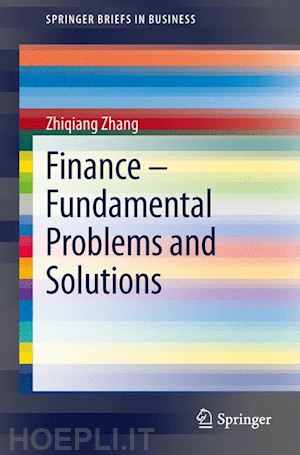
Questo prodotto usufruisce delle SPEDIZIONI GRATIS
selezionando l'opzione Corriere Veloce in fase di ordine.
Pagabile anche con Carta della cultura giovani e del merito, 18App Bonus Cultura e Carta del Docente
As indicated by the title, this book focuses on fundamental problems in finance: a logical dilemma in valuation, stock valuation methods/models, risk valuation, and optimal capital structure. It presents an innovative approach to logic and quantitative reasoning (without advanced mathematics) that delivers valuable results ---- convincing solutions to these problems. Readers in finance will definitely be interested in these solutions as well as the methods. In fact, these fundamental problems are essential in the field of finance, and they have remained unsolved (or partly unsolved) for decades. The solutions offered in this book are all sound in theory and feasible in practice, and will hopefully benefit both theoretic al research and practical decision-making.
Zhiqiang Zhang is an associate professor in the finance area at the School of Business, Renmin University of China. He currently teaches courses on corporate finance, valuation, real options etc. for the undergraduate and graduate students as well as MBA students. His primary research interests are in corporate finance and asset pricing. He has published more than 30 papers in domestic and international journals, and he has written and translated (from English to Chinese) more than 10 books in the area of finance.
His research can be summarized as three series in finance. The first series mainly concerns valuation, where he develops a brand-new approach. Based on the new valuation method, he creates a new stock valuation model, which can overcome most of the shortcomings of traditional models (such as the Gordon growth model); he further derives the theoretical models of P/E, P/B, and P/S, which are useful in stock and portfolio valuation as well as stock market bubble measuring. The second series mainly focuses on incorporating risk into valuation. He derives the theoretical models of certainty equivalents, risk equivalents (a brand new method for assessing risk), risk premiums and the new capital asset pricing model (CAPM), which accounts for both systematic and non-systematic risks. This may be the most important advance in this area since Sharpe’s CAPM (1964). The third series primarily examines firm’s capital structure decisions. Here the author solves the problem of optimal capital structure by creating new models of tax shield and bankruptcy cost and further deriving the optimal capital structure model based on the trade-off between the tax shield and the bankruptcy cost, potentially the most essential progress in this area since MM model I and II (1958 and 1963).
All solutions and models presented are theoretical and decision-oriented, and hence have broad application potential in academic research as well as in practical decision-making, especially in valuation, investment, capital budgeting, risk management, financing and capital structure decision, etc.











Il sito utilizza cookie ed altri strumenti di tracciamento che raccolgono informazioni dal dispositivo dell’utente. Oltre ai cookie tecnici ed analitici aggregati, strettamente necessari per il funzionamento di questo sito web, previo consenso dell’utente possono essere installati cookie di profilazione e marketing e cookie dei social media. Cliccando su “Accetto tutti i cookie” saranno attivate tutte le categorie di cookie. Per accettare solo deterninate categorie di cookie, cliccare invece su “Impostazioni cookie”. Chiudendo il banner o continuando a navigare saranno installati solo cookie tecnici. Per maggiori dettagli, consultare la Cookie Policy.